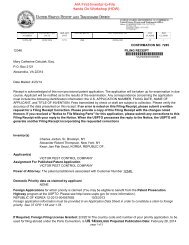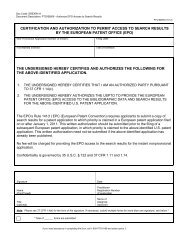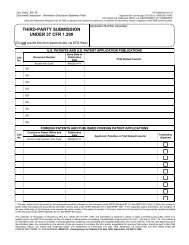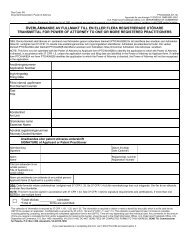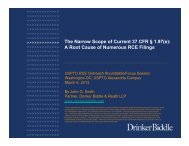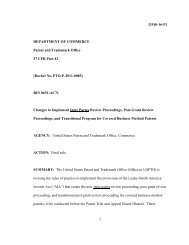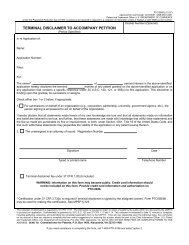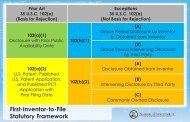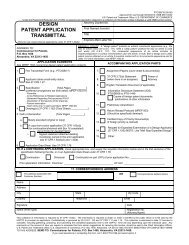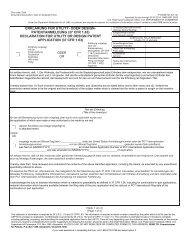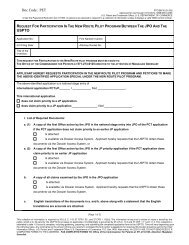ACC and IP Committee Letter regarding IPR and PGR
ACC and IP Committee Letter regarding IPR and PGR
ACC and IP Committee Letter regarding IPR and PGR
You also want an ePaper? Increase the reach of your titles
YUMPU automatically turns print PDFs into web optimized ePapers that Google loves.
April 9, 2012The Honorable David J. KapposUnder Secretary of Commerce for Intellectual Property <strong>and</strong>Director of the United States Patent <strong>and</strong> Trademark OfficeUnited States Patent <strong>and</strong> Trademark OfficeAlex<strong>and</strong>ria, VirginiaRE: <strong>ACC</strong> <strong>and</strong> its Intellectual Property <strong>Committee</strong>’s Comments on the proposed InterPartes Review <strong>and</strong> Post-Grant Review Rules of the Leahy-Smith America Invents ActDear Under Secretary Kappos:The Association of Corporate Counsel 1 <strong>and</strong> its Intellectual Property <strong>Committee</strong>respectfully submit the following comments <strong>regarding</strong> the proposed rules of the Patent <strong>and</strong>Trademark Office (“PTO”) relating to the Inter Partes Review (“<strong>IP</strong>R”) <strong>and</strong> Post-Grant Review(“<strong>PGR</strong>”) proceedings to be implemented pursuant to the America Invents Act.To deliver effective legal results for their corporate clients, in-house counsel needpredictable processes in patent challenges. Thus, for <strong>IP</strong>R <strong>and</strong> <strong>PGR</strong> proceedings to be useful tocompanies, they must be more cost-effective <strong>and</strong> predictable than litigation. To ensure costeffectiveness,the rules must create a predictable process with clear milestones <strong>and</strong> not a processthat spirals out of control due to ambiguities in the governing rules. Companies will embracethese new proceedings as a part of their overall <strong>IP</strong> strategy sooner if the initial procedures arewell-defined instead of being subject to later clarifying amendments. The rules must be bothunambiguous <strong>and</strong> fair in order for companies to consider using these procedures <strong>and</strong> budgetaccordingly. The following suggestions will cause companies to make greater use of <strong>IP</strong>R <strong>and</strong><strong>PGR</strong> proceedings <strong>and</strong> thereby provide companies <strong>and</strong> the public greater certainty <strong>regarding</strong> thequality of patents.Specifically, the <strong>ACC</strong> <strong>and</strong> its Intellectual Property <strong>Committee</strong> submit comments to theproposed claim construction procedures, discovery rules, <strong>and</strong> identification of the “real party ininterest” requirement applicable to both <strong>IP</strong>R <strong>and</strong> <strong>PGR</strong> proceedings. The comments seek toamend the proposed rules to ensure the PTO implements a certain <strong>and</strong> predictable process togovern patent challenges through <strong>IP</strong>R <strong>and</strong> <strong>PGR</strong> proceedings.1 The Association of Corporate Counsel (“<strong>ACC</strong>”) is a bar association for attorneys employed inthe legal departments of corporations <strong>and</strong> private-sector organizations worldwide. The <strong>ACC</strong> hasmore than 29,000 members in over 75 countries, employed by over 10,000 organizations.The <strong>ACC</strong> has regularly filed comments with regulatory agencies <strong>regarding</strong> rulemakings forwhich in-house counsel offer a unique perspective.1
I. Claim ConstructionThe <strong>ACC</strong> <strong>and</strong> its Intellectual Property <strong>Committee</strong> submit that the PTO should revise theproposed rules respecting claim construction procedures for <strong>IP</strong>R <strong>and</strong> <strong>PGR</strong> proceedings. Ascurrently proposed, the rules inflict an extremely heavy burden on the Petitioner at the outset ofan <strong>IP</strong>R or <strong>PGR</strong> proceeding. Moreover, the procedures under the proposed rules provide no earlyguidance to the Patentee <strong>regarding</strong> the strength <strong>and</strong> scope of its claims, leaving the Patenteeuncertain as to its best course in the proceedings. Accordingly, in-house counsel for bothPetitioners <strong>and</strong> Patentees need clarification of the rules, so the procedures are easily understood,<strong>and</strong> both fair <strong>and</strong> more useful to all parties.A. The PTO’s Proposed Rule.The proposed rules require that the Petitioner identify all claims being challenged <strong>and</strong>provide a claim construction for the challenged claims in its opening petition. (Rule 42.104;Rule 42.204). The rules also set a limit of 50 pages for <strong>IP</strong>R <strong>and</strong> 70 pages for <strong>PGR</strong> petitionsrespectively. (Rule 42.24(a)).B. The PTO’s Proposed Rules Creates a Heavy Burden on the Petitioner, YetProvides No Guidance Either to the Patentee or the Petitioner Respectingthe Scope <strong>and</strong> Strength of the Claims.The proposed rules do not provide any guidance as to the claim constructionrequirements. Since the petition will be submitted at the outset of the proceeding, the PatentTrial <strong>and</strong> Appeal Board (“PTAB”) will not be able to provide any guidance as to which termsrequire a proposed construction. Unlike many patent litigation proceedings that follow anestablished procedure in which claim terms are construed, the proposed rules for <strong>IP</strong>R <strong>and</strong> <strong>PGR</strong>require the Petitioner to construe entire patent claims in the initial petition. The Petitioner will beleft to determine which claim terms to construe <strong>and</strong> may have to err on the side of construingmore terms than necessary for fear of rejection of the petition. Furthermore, Petitioners willoften be taking claim construction positions in the petition without any indication from thePatentee as to its position on the scope of the claims. For petitions challenging multiple patentclaims, this exercise can be very burdensome. Additionally, under the proposed rules, it isunclear whether the Patentee must take a claim construction position at all, or whether it may beable to limit its response simply to an attack of the Petitioner’s proposed claim construction. Theheavy burden on the Petitioner detracts from the predictability <strong>and</strong> fairness of these proceedings<strong>and</strong> may deter companies from viewing these new procedures as effective alternativemechanisms to litigation. Moreover, the currently proposed process leaves both Petitioner <strong>and</strong>Patentee uncertain as to the anticipated course <strong>and</strong> scope of the <strong>IP</strong>R <strong>and</strong> <strong>PGR</strong> proceedings.In addition, if, as proposed, the page limits for petitions for <strong>IP</strong>R <strong>and</strong> <strong>PGR</strong> are 50 <strong>and</strong> 70respectively (Rule 42.24), Petitioners will be forced to limit the claim terms that they address.2
C. The <strong>ACC</strong> <strong>and</strong> its Intellectual Property <strong>Committee</strong>’s Proposed ChangeEnsures Fairer, More Cost-Effective, <strong>and</strong> More Certain Claim ConstructionProceedings.The PTO should eliminate the requirement that Petitioners construe the claims in theopening petition <strong>and</strong> adopt procedures similar to those established in the patent local rules of thefederal district courts that review a high volume of patent litigation matters. (See Exh. 1 – E.D.Tx. Patent R. 4 (claim construction proceedings); Exh. 2 – N.D. Cal. Patent R. 4 (claimconstruction proceedings); Exh. 3 – D.N.J. Patent R. 4 (claim construction proceedings),hereinafter “local patent rules”). The PTO should modify the deadlines established in these localpatent rules to fit its expedited <strong>IP</strong>R <strong>and</strong> <strong>PGR</strong> schedule.The PTO’s proposed rules call for an approximate six month time period between thefiling of the original petition <strong>and</strong> the PTAB’s determination of whether to institute an <strong>IP</strong>R or<strong>PGR</strong> trial. The procedures outlined below should be implemented during this six month timeperiod to facilitate evenh<strong>and</strong>ed claim construction proceedings before the PTAB.1. Exchange of Proposed Terms <strong>and</strong> Claim Elements for Construction. Not later than45 days after service of the petition for <strong>IP</strong>R or <strong>PGR</strong>, the Petitioner <strong>and</strong> the Patentee willsimultaneously exchange a list of claim terms, phrases, or clauses that each partycontends the PTAB should construe, <strong>and</strong> identify any claim element that each partycontends should be governed by 35 U.S.C. § 112(6). (Accord local patent rules 4.1(a)).This will allow the Patentee ample time to receive the petition, investigate its merits, <strong>and</strong>retain counsel as needed.The Petitioner <strong>and</strong> the Patentee should thereafter meet <strong>and</strong> confer within 10 daysfor the purposes of finalizing this list, narrowing or resolving differences, <strong>and</strong> facilitatingthe ultimate preparation of a Joint Claim Construction Statement. (Accord local patentrules 4.1(b)).2. Exchange of Preliminary Claim Constructions <strong>and</strong> Extrinsic Evidence. No later than20 days after the exchange of “Proposed Terms <strong>and</strong> Claim Elements for Construction,”the Petitioner <strong>and</strong> the Patentee should simultaneously exchange a preliminary proposedconstruction of each claim term, phrase, or clause that the parties collectively haveidentified for claim construction purposes. (Accord local patent rules 4.2(a)). For eachelement that any party contends is governed by 35 U.S.C. § 112(6), the party mustidentify the structure(s), act(s), or material(s) corresponding to that element. At the sametime, the Petitioner <strong>and</strong> the Patentee should provide a preliminary identification ofextrinsic evidence (e.g. dictionary definitions, citations to learned treatises <strong>and</strong> prior art,<strong>and</strong> testimony of percipient <strong>and</strong> expert witnesses) that supports their respective claimconstructions. (Accord local patent rules 4.2(b)).The Petitioner <strong>and</strong> the Patentee will thereafter meet <strong>and</strong> confer for the purposes ofnarrowing the issues <strong>and</strong> finalizing preparation of a Joint Claim Construction Statement.(Accord local patent rules 4.2(c)).3. Joint Claim Construction Statement. Not later than 20 days after the exchange ofpreliminary claim constructions, the Petitioner <strong>and</strong> the Patentee will complete <strong>and</strong> file a3
created therefrom, places the submitting party <strong>and</strong> practitioner in a conundrum when attemptingto articulate its relevance to the proceedings. The opposing party will, in turn, aggressivelyanalyze the written description <strong>and</strong> seek to develop arguments that the submitting partymisrepresented the submission, inevitably resulting in a rash of new inequitable conduct <strong>and</strong>/ormisconduct allegations.In addition, conflicts will arise with respect to a party’s subjective determination that apiece of information is not inconsistent with a previous position it has taken (<strong>and</strong> thus notdisclosed in the first place)—the mere failure to disclose the information will be heavilyscrutinized by third parties <strong>and</strong> asserted as a basis for inequitable conduct or misconduct. SeeTherasense, Inc. v. Becton, Dickinson <strong>and</strong> Co., 649 F.3d 1276, 1290 (Fed. Cir. 2011) (En BancFederal Circuit attempting to cure the “plague” of inequitable conduct pleadings by raising thest<strong>and</strong>ard to “clear <strong>and</strong> convincing evidence that the applicant knew of the reference, knew that itwas material, <strong>and</strong> made a deliberate decision to withhold it.”).The Rule 1.56 duty of c<strong>and</strong>or described above attaches to all parties associated with theprosecution of a matter before the PTO. This will include in-house counsel responsible formanaging <strong>IP</strong>R <strong>and</strong> <strong>PGR</strong> proceedings. Thus, the tension between the duty to the PTO <strong>and</strong> theduty zealously to advocate for one’s client is a significant concern for corporate counsel.Furthermore, the proposed rule projects a heavy cost burden on the submitting party inlocating, evaluating <strong>and</strong> describing the information. Similarly, the party receiving theinformation will incur costs from evaluating the information for evidence of bad faith on the partof the submitting party. These burdens detract from the cost predictability of the trials <strong>and</strong> willdeter companies from utilizing these proceedings.C. The PTO Should Revise Rule § 42.51(b)(3) to Eliminate the SubmittingParty’s Ethical Concerns <strong>and</strong> to Control Costs.The requirement for a written description of the information goes too far in requiring thePetitioner <strong>and</strong> patent owner to argue against their own interests, <strong>and</strong> requires the submitting partyto make interpretations <strong>and</strong> offer explanations that will result in a new line of inequitableconduct <strong>and</strong> misconduct inquiries relating thereto. The proposed rule should be changed toeliminate the requirement for a written description. Consistent with current practice under Rule1.56, the parties should be required to disclose information material to patentability withoutrequiring the submitting party to describe the information. Moreover, consistent with Rule1.97(h), disclosure of the information should not be construed as an admission that theinformation is, in fact, material to patentability. The opposing party will receive the submission<strong>and</strong> will have an opportunity—<strong>and</strong> is in fact in the best position—to evaluate the party’ssubmission <strong>and</strong> advance applicable arguments <strong>regarding</strong> prior inconsistent positions.The proposed change will eliminate the conflict that all participants will face whenevaluating information <strong>and</strong> considering how to characterize that information in a submission tothe PTO. The change will also reduce each party’s costs by eliminating the requirement for thesubmitting party to provide a written explanation of the information, <strong>and</strong> by eliminating “badfaith” or inequitable conduct claims <strong>regarding</strong> mischaracterization of the information. The6
over the Petitioner by the other party. Under the PTO’s definition of “control,” a Petitioner or anamed real party in interest may not receive a suggestion from a third party that a particularpatent should be the subject of a request for <strong>IP</strong>R or <strong>PGR</strong> <strong>and</strong> be compensated by that party forthe filing of the request without naming the third party in the petition. (See In re Guan InterPartes Reexamination Proceeding (commonly referred to as “In re Troll Busters”),Reexamination Control No. 95/001,045.)In In Re Troll-Busters, the Office of Patent Legal Administration (“the OPLA”)dismissed an Inter Partes reexamination where the real party in interest was not identified to itssatisfaction. In that case, the requester’s website described its service as completely anonymous,stating that “the Patent Troll will never know who or how many are behind the ‘hit’”(http://www.troll-busters.com/.) Based on the information posted on the Troll Busters webpages, the PTO issued a show cause order to establish the identity of the real party in interest.The PTO was not persuaded by Troll-Busters’ showing <strong>and</strong> terminated the reexamination statingthat “Troll Busters cannot act as a ‘shill’ in an INTER PARTES reexamination request to shieldthe identity of the real party or parties in interest.” (No. 95/001,045, “Decision Vacating FilingDate,” p. 7 (mailed Aug 25, 2008).) The PTO concluded that “an entity may not be paid, or bedirected or controlled as to the manner in which the request for Inter Partes reexamination isfiled for a given patent, without naming the party or parties who paid for, or directed/controlled,the filing of the request for Inter Partes reexamination.” (Id. at p. 8.)The PTO should adopt the common law general agency concepts it has already applied,where a principal is bound by the acts of an agent when the principal, expressly or impliedly,authorizes the agent to work under its control <strong>and</strong> on its behalf. (See O'Neill v. Department ofHousing <strong>and</strong> Urban Development, 220 F.3d 1354, 1360 (Fed. Cir. 2000) (“Agency ‘is thefiduciary relation which results from the manifestation of consent by one person to another thatthe other shall act on his behalf <strong>and</strong> subject to his control, <strong>and</strong> consent by the other to so act.’Restatement (Second) of Agency § 1 (1958). An agent acting on behalf of his principal has theauthority to ‘alter the legal relations between the principal <strong>and</strong> third persons,’ id. § 12, <strong>and</strong> a‘principal has the right to control the conduct of the agent with respect to matters entrusted tohim,’ id. § 14. Thus, proof of actual or apparent authority, see id. § 8, to act on behalf of theprincipal is necessary to establish that a person acts as an agent…under the common-law.”)).Therefore, the terms “real party in interest” <strong>and</strong> “privy” should be defined to include an entitythat pays for, directs/controls, <strong>and</strong> suggests that a separate entity file a petition for <strong>PGR</strong> or <strong>IP</strong>R.Companies often join trade associations to better address industry-wide issues includingpatent issues. Companies rely on such trade associations to spearhead/coordinate challenges topatents in some cases <strong>and</strong> create efficiencies of scale due to the expense of litigating patentrelated matters. The <strong>ACC</strong> believes that a company, which is merely a passive member of a tradeassociation that is petitioning for an <strong>IP</strong>R or <strong>PGR</strong>, should not be a real party in interest under therules, unless the company pays for, directs/controls, <strong>and</strong> makes suggestions to the tradeassociation directly related to the <strong>IP</strong>R or <strong>PGR</strong> proceeding.This proposed change is a balanced approach that will clarify <strong>and</strong> circumscribe thepreclusive effect of <strong>IP</strong>R <strong>and</strong> <strong>PGR</strong> proceedings, while preventing serial administrative challenges8
to patents by related parties that exercise control over <strong>and</strong> provide funding to the Petitioner ofrecord.IV. ConclusionWe believe that the foregoing revisions to the rules will ensure that the PTO deliversefficient, cost-effective legal outcomes for all parties engaging in <strong>IP</strong>R or <strong>PGR</strong> proceedings.Adoption of the <strong>ACC</strong>’s proposals will encourage companies to embrace these new proceedingsas a part of their overall Intellectual Property strategy <strong>and</strong> will provide companies <strong>and</strong> the publicgreater certainty <strong>regarding</strong> the quality of patents.The <strong>ACC</strong> <strong>and</strong> its Intellectual Property <strong>Committee</strong> sincerely appreciate the opportunity toprovide these comments <strong>and</strong> welcome any questions respecting them.Sincerely,Monica Winghart<strong>Committee</strong> ChairIntellectual Property <strong>Committee</strong>Douglas B. LuftmanAdvocacy Subcommittee ChairIntellectual Property <strong>Committee</strong>Amar D. SarwalVice President <strong>and</strong> Chief Legal StrategistAssociation of Corporate Counsel1025 Connecticut Avenue, N.W., Suite 200Washington, D.C. 20036(202) 293-4103 x3659
EXHIBIT 1
- Current as of April 21, 2011APPENDIX MPATENT RULES1. SCOPE OF RULES1-1. Title.These are the Rules of Practice for Patent Cases before the Eastern District of Texas. They shouldbe cited as “P. R. __.”1-2. Scope <strong>and</strong> Construction.These rules apply to all civil actions filed in or transferred to this Court which allege infringementof a utility patent in a complaint, counterclaim, cross-claim or third party claim, or which seek adeclaratory judgment that a utility patent is not infringed, is invalid or is unenforceable. The Courtmay accelerate, extend, eliminate, or modify the obligations or deadlines set forth in these PatentRules based on the circumstances of any particular case, including, without limitation, thecomplexity of the case or the number of patents, claims, products, or parties involved. If any motionfiled prior to the Claim Construction Hearing provided for in P. R. 4-6 raises claim constructionissues, the Court may, for good cause shown, defer the motion until after completion of thedisclosures, filings, or ruling following the Claim Construction Hearing. The Civil Local Rules ofthis Court shall also apply to these actions, except to the extent that they are inconsistent with thesePatent Rules. The deadlines set forth in these rules may be modified by Docket Control Order issuedin specific cases.1-3. Effective Date.These Patent Rules shall take effect on February 22, 2005 <strong>and</strong> shall apply to any case filed thereafter<strong>and</strong> to any pending case in which more than 9 days remain before the Initial Disclosure of AssertedClaims is made. The parties to any other pending civil action shall meet <strong>and</strong> confer promptly afterFebruary 22, 2005, for the purpose of determining whether any provision in these Patent Rules
should be made applicable to that case. No later than 7 days after the parties meet <strong>and</strong> confer, theparties shall file a stipulation setting forth a proposed order that relates to the application of thesePatent Rules. Unless <strong>and</strong> until an order is entered applying these Patent Local Rules to any pendingcase, the Rules previously applicable to pending patent cases shall govern.2. GENERAL PROVISIONS2-1. Governing Procedure.(a) Initial Case Management Conference. Prior to the Initial Case Management Conference withthe Court, when the parties confer with each other pursuant to Fed.R.Civ.P. 26(f), in addition to thematters covered by Fed.R.Civ.P. 26, the parties must discuss <strong>and</strong> address in the Case ManagementStatement filed pursuant to Fed.R.Civ.P. 26(f), the following topics:(1) Proposed modification of the deadlines provided for in the Patent Rules, <strong>and</strong> the effectof any such modification on the date <strong>and</strong> time of the Claim Construction Hearing, if any;(2) Whether the Court will hear live testimony at the Claim Construction Hearing;(3) The need for <strong>and</strong> any specific limits on discovery relating to claim construction,including depositions of witnesses, including expert witnesses;(4) The order of presentation at the Claim Construction Hearing; <strong>and</strong>(5) The scheduling of a Claim Construction Prehearing Conference to be held after the JointClaim Construction <strong>and</strong> Prehearing Statement provided for in P. R. 4-3 has been filed.(6) Whether the court should authorize the filing under seal of any documents containingconfidential information.2
(b) Further Case Management Conferences. To the extent that some or all of the matters providedfor in P. R. 2-1 (a)(1)-(5) are not resolved or decided at the Initial Case Management Conference,the parties shall propose dates for further Case Management Conferences at which such matters shallbe decided.(c) Electronic Filings. All patents attached as exhibits to any filing submitted electronically shallbe in searchable PDF format. Any other documents attached as exhibits to any filing submittedelectronically should be in searchable PDF format whenever possible.2-2. Confidentiality.If any document or information produced under these Patent Local Rules is deemed confidential bythe producing party <strong>and</strong> if the Court has not entered a protective order, until a protective order isissued by the Court, the document shall be marked “confidential” or with some other confidentialdesignation (such as “Confidential – Outside Attorneys Eyes Only”) by the disclosing party <strong>and</strong>disclosure of the confidential document or information shall be limited to each party’s outsideattorney(s) of record <strong>and</strong> the employees of such outside attorney(s).If a party is not represented by an outside attorney, disclosure of the confidential document orinformation shall be limited to one designated “in house” attorney, whose identity <strong>and</strong> job functionsshall be disclosed to the producing party 5 court days prior to any such disclosure, in order to permitany motion for protective order or other relief <strong>regarding</strong> such disclosure. The person(s) to whomdisclosure of a confidential document or information is made under this local rule shall keep itconfidential <strong>and</strong> use it only for purposes of litigating the case.2-3. Certification of Initial Disclosures.All statements, disclosures, or charts filed or served in accordance with these Patent Rules must be3
dated <strong>and</strong> signed by counsel of record. Counsel’s signature shall constitute a certification that to thebest of his or her knowledge, information, <strong>and</strong> belief, formed after an inquiry that is reasonableunder the circumstances, the information contained in the statement, disclosure, or chart is complete<strong>and</strong> correct at the time it is made.2-4. Admissibility of Disclosures.Statements, disclosures, or charts governed by these Patent Rules are admissible to the extentpermitted by the Federal Rules of Evidence or Procedure. However, the statements or disclosuresprovided for in P. R. 4-1 <strong>and</strong> 4-2 are not admissible for any purpose other than in connection withmotions seeking an extension or modification of the time periods within which actions contemplatedby these Patent Rules must be taken.2-5. Relationship to Federal Rules of Civil Procedure.Except as provided in this paragraph or as otherwise ordered, it shall not be a legitimate ground forobjecting to an opposing party’s discovery request (e.g., interrogatory, document request, requestfor admission, deposition question) or declining to provide information otherwise required to bedisclosed pursuant to Fed.R.Civ.P. 26(a)(1) that the discovery request or disclosure requirement ispremature in light of, or otherwise conflicts with, these Patent Rules. A party may object, however,to responding to the following categories of discovery requests (or decline to provide informationin its initial disclosures under Fed.R.Civ.P. 26(a)(1)) on the ground that they are premature in lightof the timetable provided in the Patent Rules:(a) Requests seeking to elicit a party’s claim construction position;(b) Requests seeking to elicit from the patent claimant a comparison of the asserted claims <strong>and</strong> theaccused apparatus, product, device, process, method, act, or other instrumentality;4
(c) Requests seeking to elicit from an accused infringer a comparison of the asserted claims <strong>and</strong> theprior art; <strong>and</strong>(d) Requests seeking to elicit from an accused infringer the identification of any opinions of counsel,<strong>and</strong> related documents, that it intends to rely upon as a defense to an allegation of willfulinfringement.Where a party properly objects to a discovery request (or declines to provide information in its initialdisclosures under Fed.R.Civ.P. 26(a)(1)) as set forth above, that party shall provide the requestedinformation on the date on which it is required to provide the requested information to an opposingparty under these Patent Rules, unless there exists another legitimate ground for objection.3. PATENT INITIAL DISCLOSURES3-1. Disclosure of Asserted Claims <strong>and</strong> Infringement Contentions.Not later than 10 days before the Initial Case Management Conference with the Court, a partyclaiming patent infringement must serve on all parties a “Disclosure of Asserted Claims <strong>and</strong>Infringement Contentions.” Separately for each opposing party, the “Disclosure of Asserted Claims<strong>and</strong> Infringement Contentions” shall contain the following information:(a) Each claim of each patent in suit that is allegedly infringed by each opposing party;(b) Separately for each asserted claim, each accused apparatus, product, device, process, method,act, or other instrumentality (“Accused Instrumentality”) of each opposing party of which the partyis aware. This identification shall be as specific as possible. Each product, device, <strong>and</strong> apparatusmust be identified by name or model number, if known. Each method or process must be identifiedby name, if known, or by any product, device, or apparatus which, when used, allegedly results inthe practice of the claimed method or process;5
(c) A chart identifying specifically where each element of each asserted claim is found within eachAccused Instrumentality, including for each element that such party contends is governed by 35U.S.C. § 112(6), the identity of the structure(s), act(s), or material(s) in the Accused Instrumentalitythat performs the claimed function;(d) Whether each element of each asserted claim is claimed to be literally present or present underthe doctrine of equivalents in the Accused Instrumentality;(e) For any patent that claims priority to an earlier application, the priority date to which eachasserted claim allegedly is entitled; <strong>and</strong>(f) If a party claiming patent infringement wishes to preserve the right to rely, for any purpose, onthe assertion that its own apparatus, product, device, process, method, act, or other instrumentalitypractices the claimed invention, the party must identify, separately for each asserted claim, each suchapparatus, product, device, process, method, act, or other instrumentality that incorporates or reflectsthat particular claim.3-2. Document Production Accompanying Disclosure.With the “Disclosure of Asserted Claims <strong>and</strong> Infringement Contentions,” the party claiming patentinfringement must produce to each opposing party or make available for inspection <strong>and</strong> copying:(a) Documents (e.g., contracts, purchase orders, invoices, advertisements, marketing materials, offerletters, beta site testing agreements, <strong>and</strong> third party or joint development agreements) sufficient toevidence each discussion with, disclosure to, or other manner of providing to a third party, or saleof or offer to sell, the claimed invention prior to the date of application for the patent in suit. Aparty’s production of a document as required herein shall not constitute an admission that suchdocument evidences or is prior art under 35 U.S.C. § 102;6
(b) All documents evidencing the conception, reduction to practice, design, <strong>and</strong> development of eachclaimed invention, which were created on or before the date of application for the patent in suit orthe priority date identified pursuant to P. R. 3-1(e), whichever is earlier; <strong>and</strong>(c) A copy of the file history for each patent in suit.The producing party shall separately identify by production number which documents correspondto each category.3-3. Invalidity Contentions.Not later than 45 days after service upon it of the “Disclosure of Asserted Claims <strong>and</strong> InfringementContentions,” each party opposing a claim of patent infringement, shall serve on all parties its“Invalidity Contentions” which must contain the following information:(a) The identity of each item of prior art that allegedly anticipates each asserted claim or renders itobvious. Each prior art patent shall be identified by its number, country of origin, <strong>and</strong> date of issue.Each prior art publication must be identified by its title, date of publication, <strong>and</strong> where feasible,author <strong>and</strong> publisher. Prior art under 35 U.S.C. § 102(b) shall be identified by specifying the itemoffered for sale or publicly used or known, the date the offer or use took place or the informationbecame known, <strong>and</strong> the identity of the person or entity which made the use or which made <strong>and</strong>received the offer, or the person or entity which made the information known or to whom it wasmade known. Prior art under 35 U.S.C. § 102(f) shall be identified by providing the name of theperson(s) from whom <strong>and</strong> the circumstances under which the invention or any part of it was derived.Prior art under 35 U.S.C. § 102(g) shall be identified by providing the identities of the person(s) orentities involved in <strong>and</strong> the circumstances surrounding the making of the invention before the patentapplicant(s);(b) Whether each item of prior art anticipates each asserted claim or renders it obvious. If a7
is made by a party. If the defendant does not assert a claim for patent infringement in its answer tothe complaint, no later than 10 days after the defendant serves its answer, or 10 days after the InitialCase Management Conference, whichever is later, the party seeking a declaratory judgment mustserve upon each opposing party its Invalidity Contentions that conform to P. R. 3-3 <strong>and</strong> produce ormake available for inspection <strong>and</strong> copying the documents described in P. R. 3-4. The parties shallmeet <strong>and</strong> confer within 10 days of the service of the Invalidity Contentions for the purpose ofdetermining the date on which the plaintiff will file its Final Invalidity Contentions which shall beno later than 50 days after service by the Court of its Claim Construction Ruling.(b) Applications of Rules When No Specified Triggering Event. If the filings or actions in a casedo not trigger the application of these Patent Rules under the terms set forth herein, the parties shall,as soon as such circumstances become known, meet <strong>and</strong> confer for the purpose of agreeing on theapplication of these Patent Rules to the case.(c) Inapplicability of Rule. This P. R. 3-5 shall not apply to cases in which a request for adeclaratory judgment that a patent is not infringed, is invalid, or is unenforceable is filed in responseto a complaint for infringement of the same patent.9
3-6. Amending Contentions.(a) Leave not required. Each party’s “Infringement Contentions” <strong>and</strong> “Invalidity Contentions”shall be deemed to be that party’s final contentions, except as set forth below.(1) If a party claiming patent infringement believes in good faith that the Court’s ClaimConstruction Ruling so requires, not later than 30 days after service by the Court of its ClaimConstruction Ruling, that party may serve “Amended Infringement Contentions” withoutleave of court that amend its “Infringement Contentions” with respect to the informationrequired by Patent R. 3-1(c) <strong>and</strong> (d).(2) Not later than 50 days after service by the Court of its Claim Construction Ruling, eachparty opposing a claim of patent infringement may serve “Amended Invalidity Contentions”without leave of court that amend its “Invalidity Contentions” with respect to the informationrequired by P. R. 3-3 if:(A) a party claiming patent infringement has served “Infringement Contentions”pursuant to P. R. 3-6(a), or(B) the party opposing a claim of patent infringement believes in good faith that theCourt’s Claim Construction Ruling so requires.(b) Leave required. Amendment or supplementation any Infringement Contentions or InvalidityContentions, other than as expressly permitted in P. R. 3-6(a), may be made only by order of theCourt, which shall be entered only upon a showing of good cause.3-7 Opinion of Counsel DefensesBy the date set forth in the Docket Control Order, each party opposing a claim of patent10
infringement that will rely on an opinion of counsel as part of a defense shall:(a) Produce or make available for inspection <strong>and</strong> copying the opinion(s) <strong>and</strong> any other documentsrelating to the opinion(s) as to which that party agrees the attorney-client or work product protectionhas been waived; <strong>and</strong>(b) Serve a privilege log identifying any other documents, except those authored by counsel actingsolely as trial counsel, relating to the subject matter of the opinion(s) which the party is withholdingon the grounds of attorney-client privilege or work product protection.A party opposing a claim of patent infringement who does not comply with the requirements of thisP. R. 3-7 shall not be permitted to rely on an opinion of counsel as part of a defense absent astipulation of all parties or by order of the Court, which shall be entered only upon a showing ofgood cause.3-8. Disclosure Requirements for Patent Cases Arising Under 21 U.S.C. § 355 (Hatch-Waxman Act).The following provision applies to all patents subject to a Paragraph IV certification in cases arisingunder 21 U.S.C. § 355 (commonly referred to as “the Hatch-Waxman Act”). This provision takesprecedence over any conflicting provisions in P.R. 3-1 to 3-5 for all cases arising under 21 U.S.C.§ 355.(a) At or before the Initial Case Management Conference, the Defendant(s) shall produce toPlaintiff(s) the entire Abbreviated New Drug Application or New Drug Application that is the basisof the case in question.(b) Not more than 14 days after the Initial Case Management Conference, the Defendant(s) shallprovide to Plaintiff(s) the written basis for their “Invalidity Contentions” for any patents referred11
to in Defendant(s) Paragraph IV Certification. This written basis shall contain all disclosuresrequired by P.R. 3-3 <strong>and</strong> shall be accompanied by the production of documents required by P.R. 3-4.(c) Not more than 14 days after the Initial Case Management Conference, the Defendant(s) shallprovide to Plaintiff(s) the written basis for any defense of non-infringement for any patent referredto in Defendant(s) Paragraph IV Certification. This written basis shall include a claim chartidentifying each claim at issue in the case <strong>and</strong> each limitation of each claim at issue. The claim chartshall specifically identify for each claim those claim limitation(s) that are literally absent from theDefendant(s) allegedly infringing Abbreviated New Drug Application or New Drug Application.The written basis for any defense of non-infringement shall also be accompanied by the productionof any document or thing that the Defendant(s) intend to rely upon in defense of any infringementallegations by Plaintiff(s).(d) Not more than 45 days after the disclosure of the written basis for any defense of noninfringementas required by P.R. 3-8(c), Plaintiff(s) shall provide Defendant(s) with a “Disclosureof Asserted Claims <strong>and</strong> Infringement Contentions,” for all patents referred to in Defendant(s)Paragraph IV Certification, which shall contain all disclosures required by P.R. 3-1 <strong>and</strong> shall beaccompanied by the production of documents required by P.R. 3-2.4. CLAIM CONSTRUCTION PROCEEDINGS4-1. Exchange of Proposed Terms <strong>and</strong> Claim Elements for Construction.(a) Not later than 10 days after service of the “Invalidity Contentions” pursuant to P. R. 3-3, eachparty shall simultaneously exchange a list of claim terms, phrases, or clauses which that partycontends should be construed by the Court, <strong>and</strong> identify any claim element which that partycontends should be governed by 35 U.S.C. § 112(6).(b) The parties shall thereafter meet <strong>and</strong> confer for the purposes of finalizing this list, narrowing or12
esolving differences, <strong>and</strong> facilitating the ultimate preparation of a Joint Claim Construction <strong>and</strong>Prehearing Statement.4-2. Exchange of Preliminary Claim Constructions <strong>and</strong> Extrinsic Evidence.(a) Not later than 20 days after the exchange of “Proposed Terms <strong>and</strong> Claim Elements forConstruction” pursuant to P. R. 4-1, the parties shall simultaneously exchange a preliminaryproposed construction of each claim term, phrase, or clause which the parties collectively haveidentified for claim construction purposes. Each such “Preliminary Claim Construction” shall also,for each element which any party contends is governed by 35 U.S.C. § 112(6), identify thestructure(s), act(s), or material(s) corresponding to that element.(b) At the same time the parties exchange their respective “Preliminary Claim Constructions,” theyshall each also provide a preliminary identification of extrinsic evidence, including withoutlimitation, dictionary definitions, citations to learned treatises <strong>and</strong> prior art, <strong>and</strong> testimony ofpercipient <strong>and</strong> expert witnesses they contend support their respective claim constructions. Theparties shall identify each such item of extrinsic evidence by production number or produce a copyof any such item not previously produced. With respect to any such witness, percipient or expert,the parties shall also provide a brief description of the substance of that witness’ proposed testimony.(c) The parties shall thereafter meet <strong>and</strong> confer for the purposes of narrowing the issues <strong>and</strong>finalizing preparation of a Joint Claim Construction <strong>and</strong> Prehearing Statement.4-3. Joint Claim Construction <strong>and</strong> Prehearing Statement.Not later than 60 days after service of the “Invalidity Contentions,” the parties shall complete <strong>and</strong>file a Joint Claim Construction <strong>and</strong> Prehearing Statement, which shall contain the followinginformation:13
(a) The construction of those claim terms, phrases, or clauses on which the parties agree;(b) Each party’s proposed construction of each disputed claim term, phrase, or clause, together withan identification of all references from the specification or prosecution history that support thatconstruction, <strong>and</strong> an identification of any extrinsic evidence known to the party on which it intendsto rely either to support its proposed construction of the claim or to oppose any other party’sproposed construction of the claim, including, but not limited to, as permitted by law, dictionarydefinitions, citations to learned treatises <strong>and</strong> prior art, <strong>and</strong> testimony of percipient <strong>and</strong> expertwitnesses;(c) The anticipated length of time necessary for the Claim Construction Hearing;(d) Whether any party proposes to call one or more witnesses, including experts, at the ClaimConstruction Hearing, the identity of each such witness, <strong>and</strong> for each expert, a summary of eachopinion to be offered in sufficient detail to permit a meaningful deposition of that expert; <strong>and</strong>(e) A list of any other issues which might appropriately be taken up at a prehearing conference priorto the Claim Construction Hearing, <strong>and</strong> proposed dates, if not previously set, for any such prehearingconference.4-4. Completion of Claim Construction Discovery.Not later than 30 days after service <strong>and</strong> filing of the Joint Claim Construction <strong>and</strong> PrehearingStatement, the parties shall complete all discovery relating to claim construction, including anydepositions with respect to claim construction of any witnesses, including experts, identified in theJoint Claim Construction <strong>and</strong> Prehearing Statement.4-5. Claim Construction Briefs.14
(a) Not later than 45 days after serving <strong>and</strong> filing the Joint Claim Construction <strong>and</strong> PrehearingStatement, the party claiming patent infringement shall serve <strong>and</strong> file an opening brief <strong>and</strong> anyevidence supporting its claim construction. All asserted patents shall be attached as exhibits to theopening claim construction brief in searchable PDF form.(b) Not later than 14 days after service upon it of an opening brief, each opposing party shall serve<strong>and</strong> file its responsive brief <strong>and</strong> supporting evidence.(c) Not later than 7 days after service upon it of a responsive brief, the party claiming patentinfringement shall serve <strong>and</strong> file any reply brief <strong>and</strong> any evidence directly rebutting the supportingevidence contained in an opposing party’s response.(d) At least 10 days before the Claim Construction Hearing held pursuant to P.R. 4-6, the partiesshall jointly submit a claim construction chart on computer disk in WordPerfect format or in suchother format as the Court may direct.(1) Said chart shall have a column listing complete language of disputed claims withdisputed terms in bold type <strong>and</strong> separate columns for each party’s proposed construction ofeach disputed term. The chart shall also include a fourth column entitled “Court’sConstruction” <strong>and</strong> otherwise left blank. Additionally, the chart shall also direct the Court’sattention to the patent <strong>and</strong> claim number(s) where the disputed term(s) appear(s).(2) The parties may also include constructions for claim terms to which they have agreed.If the parties choose to include agreed constructions, each party’s proposed constructioncolumns shall state “[AGREED]” <strong>and</strong> the agreed construction shall be inserted in the“Court’s Construction” column.(3) The purpose of this claim construction chart is to assist the Court <strong>and</strong> the parties intracking <strong>and</strong> resolving disputed terms. Accordingly, aside from the requirements set forth15
in this rule, the parties are afforded substantial latitude in the chart’s format so that they mayfashion a chart that most clearly <strong>and</strong> efficiently outlines the disputed terms <strong>and</strong> proposedconstructions. Appendices to the Court’s prior published <strong>and</strong> unpublished claimconstruction opinions may provide helpful guidelines for parties fashioning claimconstruction charts.(e) Unless otherwise ordered by the Court, the page limitations governing dispositive motionspursuant to Local Rule CV-7(a) shall apply to claim construction briefing.4-6. Claim Construction Hearing.Subject to the convenience of the Court’s calendar, two weeks following submission of the replybrief specified in P.R. 4-5(c), the Court shall conduct a Claim Construction Hearing, to the extentthe parties or the Court believe a hearing is necessary for construction of the claims at issue.16
EXHIBIT 2
UNITED STATES DISTRICT COURTNorthern District of CaliforniaPATENT LOCAL RULESTable of Contents 1. SCOPE OF RULES ..................................................................................................................... PAT-11-1. Title .................................................................................................................................. PAT-11-2. Scope <strong>and</strong> Construction .................................................................................................... PAT-11-3. Modification of these Rules ............................................................................................. PAT-11-4. Effective Date ................................................................................................................... PAT-12. GENERAL PROVISIONS .......................................................................................................... PAT-22-1. Governing Procedure ........................................................................................................ PAT-2(a) Initial Case Management Conference ................................................................... PAT-22-2. Confidentiality .................................................................................................................. PAT-22-3. Certification of Disclosures .............................................................................................. PAT-22-4. Admissibility of Disclosures ............................................................................................ PAT-22-5. Relationship to Federal Rules of Civil Procedure ............................................................ PAT-23. PATENT DISCLOSURES .......................................................................................................... PAT-43-1. Disclosure of Asserted Claims <strong>and</strong> Infringement Contentions ........................................ PAT-43-2. Document Production Accompanying Disclosure ........................................................... PAT-43-3. Invalidity Contentions ...................................................................................................... PAT-53-4. Document Production Accompanying Invalidity Contentions ......................................... PAT-63-5. Disclosure Requirement in Patent Cases for Declaratory Judgment of Invalidity ........... PAT-6(a) Invalidity Contentions If No Claim of Infringement .............................................. PAT-6(b) Inapplicability of Rule ............................................................................................ PAT-63-6. Amendment to Contentions .............................................................................................. PAT-63-7. Advice of Counsel ............................................................................................................ PAT-74. CLAIM CONSTRUCTION PROCEEDINGS ............................................................................ PAT-84-1. Exchange of Proposed Terms for Construction ................................................................ PAT-84-2. Exchange of Preliminary Claim Constructions <strong>and</strong> Extrinsic Evidence .......................... PAT-84-3. Joint Claim Construction <strong>and</strong> Prehearing Statement ........................................................ PAT-84-4. Completion of Claim Construction Discovery ................................................................. PAT-94-5. Claim Construction Briefs ................................................................................................ PAT-94-6. Claim Construction Hearing ........................................................................................... PAT-104-7. Good Faith Participation ................................................................................................ PAT-10USDC Patent Local Rules Revised December 1, 2009PAT-i
1. SC OPE O F RU L ES1-1. TitleThese are the Local Rules of Practice for Patent Cases before the United States District Court1-2. Scope <strong>and</strong> ConstructionThese rules apply to all civil actions filed in or transferred to this Court which allegeinfringement of a utility patent in a complaint, counterclaim, cross-claim or third party claim, orwhich seek a declaratory judgment that a utility patent is not infringed, is invalid or isunenforceable. The Civil Local Rules of this Court shall also apply to such actions, except tothe extent that they are inconsistent with these Patent Local Rules. If the filings or actions in acase do not trigger the application of these Patent Local Rules under the terms set forth herein,the parties shall, as soon as such circumstances become known, meet <strong>and</strong> confer for the purposeof agreeing on the application of these Patent Local Rules to the case <strong>and</strong> promptly report theresults of the meet <strong>and</strong> confer to the Court.1-3. Modification of these RulesThe Court may modify the obligations or deadlines set forth in these Patent Local Rules basedon the circumstances of any particular case, including, without limitation, the simplicity orcomplexity of the case as shown by the patents, claims, products, or parties involved. Suchmodifications shall, in most cases, be made at the initial case management conference, but maybe made at other times upon a showing of good cause. In advance of submission of any requestfor a modification, the parties shall meet <strong>and</strong> confer for purposes of reaching an agreement, ifpossible, upon any modification.1-4. Effective DateThese Patent Local Rules take effect on December 1, 2009. They govern patent cases filed onor after that date. For actions pending prior to December 1, 2009, the provisions of the PatentLocal Rules that were in effect on November 30, 2009, shall apply, except that the time periodsfor actions pending before December 1, 2009 shall be those set forth in <strong>and</strong> computed as in theFederal Rules of Civil Procedure <strong>and</strong> the Patent Local Rules that took effect on December 1,2009.USDC Patent Local Rules Revised December 1, 2009PAT-1
2. G E N E R A L PR O V ISI O NS2-1. Governing Procedure(a) Initial Case Management Conference. When the parties confer pursuant to Fed. R.Civ. P. 26(f), in addition to the matters covered by Fed. R. Civ. P. 26, the parties shalldiscuss <strong>and</strong> address in the Case Management Statement filed pursuant to Fed. R. Civ. P.26(f) <strong>and</strong> Civil L.R. 16-9, the following topics:(1) Proposed modification of the obligations or deadlines set forth in these PatentLocal Rules to ensure that they are suitable for the circumstances of the particularcase (see Patent L.R. 1-3);(2) The scope <strong>and</strong> timing of any claim construction discovery including disclosure of<strong>and</strong> discovery from any expert witness permitted by the court;(3) The format of the Claim Construction Hearing, including whether the Court willhear live testimony, the order of presentation, <strong>and</strong> the estimated length of thehearing; <strong>and</strong>(4) How the parties intend to educate the court on the technology at issue.2-2. ConfidentialityDiscovery cannot be withheld on the basis of confidentiality absent Court order. The ProtectiveOrder authorized by the Northern District of California shall govern discovery unless the Courtwebsite.2-3. Certification of DisclosuresAll statements, disclosures, or charts filed or served in accordance with these Patent Localcertification that to the best of his or her knowledge, information, <strong>and</strong> belief, formed after aninquiry that is reasonable under the circumstances, the information contained in the statement,disclosure, or chart is complete <strong>and</strong> correct at the time it is made.2-4. Admissibility of DisclosuresStatements, disclosures, or charts governed by these Patent Local Rules are admissible to theextent permitted by the Federal Rules of Evidence or Procedure. However, the statements <strong>and</strong>disclosures provided for in Patent L.R. 4-1 <strong>and</strong> 4-2 are not admissible for any purpose otherthan in connection with motions seeking an extension or modification of the time periodswithin which actions contemplated by these Patent Local Rules shall be taken.2-5. Relationship to Federal Rules of Civil ProcedureExcept as provided in this paragraph or as otherwise ordered, it shall not be a ground forrequest for admission, deposition question) or declining to provide information otherwiserequired to be disclosed pursuant to Fed. R. Civ. P. 26(a)(1) that the discovery request ordisclosure requirement is premature in light of, or otherwise conflicts with, these Patent LocalRules, absent other legitimate objection. A party may object, however, to responding to theUSDC Patent Local Rules Revised December 1, 2009PAT-2
following categories of discovery requests (or decline to provide information in its initialdisclosures under Fed. R. Civ. P. 26(a)(1)) on the ground that they are premature in light of thetimetable provided in the Patent Local Rules:(a)(b)(c)(d)Requests seeking to elicit from the patent claimant a comparison of the asserted claims<strong>and</strong> the accused apparatus, product, device, process, method, act, or other instrumentality;Requests seeking to elicit from an accused infringer a comparison of the asserted claims<strong>and</strong> the prior art; <strong>and</strong>Requests seeking to elicit from an accused infringer the identification of any advice ofcounsel, <strong>and</strong> related documents.Where a party properly objects to a discovery request (or declines to provide information in itsinitial disclosures under Fed. R. Civ. P. 26(a)(1)) as set forth above, that party shall provide therequested information on the date on which it is required to be provided to an opposing partyunder these Patent Local Rules or as set by the Court, unless there exists another legitimateground for objection.USDC Patent Local Rules Revised December 1, 2009PAT-3
3. PA T E N T DISC L OSUR ES3-1. Disclosure of Asserted Claims <strong>and</strong> Infringement ContentionsNot later than 14 days after the Initial Case Management Conference, a party claiming patentInfrin(a)(b)(c)(d)(e)(f)(g)(h)Each claim of each patent in suit that is allegedly infringed by each opposing party,including for each claim the applicable statutory subsections of 35 U.S.C. §271 asserted;Separately for each asserted claim, each accused apparatus, product, device, process,of which the party is aware. This identification shall be as specific as possible. Eachproduct, device, <strong>and</strong> apparatus shall be identified by name or model number, if known.Each method or process shall be identified by name, if known, or by any product, device,or apparatus which, when used, allegedly results in the practice of the claimed method orprocess;A chart identifying specifically where each limitation of each asserted claim is foundwithin each Accused Instrumentality, including for each limitation that such partycontends is governed by 35 U.S.C. § 112(6), the identity of the structure(s), act(s), ormaterial(s) in the Accused Instrumentality that performs the claimed function.For each claim which is alleged to have been indirectly infringed, an identification of anydirect infringement <strong>and</strong> a description of the acts of the alleged indirect infringer thatcontribute to or are inducing that direct infringement. Insofar as alleged directinfringement is based on joint acts of multiple parties, the role of each such party in thedirect infringement must be described.Whether each limitation of each asserted claim is alleged to be literally present or presentunder the doctrine of equivalents in the Accused Instrumentality;For any patent that claims priority to an earlier application, the priority date to whicheach asserted claim allegedly is entitled; <strong>and</strong>If a party claiming patent infringement wishes to preserve the right to rely, for anypurpose, on the assertion that its own apparatus, product, device, process, method, act, orother instrumentality practices the claimed invention, the party shall identify, separatelyfor each asserted claim, each such apparatus, product, device, process, method, act, orother instrumentality that incorporates or reflects that particular claim.If a party claiming patent infringement alleges willful infringement, the basis for suchallegation.3-2. Document Production Accompanying Disclosurepatent infringement shall produce to each opposing party or make available for inspection <strong>and</strong>copying:USDC Patent Local Rules Revised December 1, 2009PAT-4
(a)(b)(c)(d)(e)Documents (e.g., contracts, purchase orders, invoices, advertisements, marketingmaterials, offer letters, beta site testing agreements, <strong>and</strong> third party or joint developmentagreements) sufficient to evidence each discussion with, disclosure to, or other manner ofproviding to a third party, or sale of or offer to sell, or any public use of, the claimeddocument as required herein shall not constitute an admission that such documentevidences or is prior art under 35 U.S.C. § 102;All documents evidencing the conception, reduction to practice, design, <strong>and</strong> developmentof each claimed invention, which were created on or before the date of application for thepatent in suit or the priority date identified pursuant to Patent L.R. 3-1(f), whichever isearlier;A copy of the file history for each patent in suit; <strong>and</strong>All documents evidencing ownership of the patent rights by the party asserting patentinfringement.If a party identifies instrumentalities pursuant to Patent L.R. 3-1(g), documents sufficientto show the operation of any aspects or elements of such instrumentalities the patentclaimant relies upon as embodying any asserted claims.The producing party shall separately identify by production number which documentscorrespond to each category.3-3. Invalidity ContentionsInfringem(a)(b)The identity of each item of prior art that allegedly anticipates each asserted claim orrenders it obvious. Each prior art patent shall be identified by its number, country oforigin, <strong>and</strong> date of issue. Each prior art publication shall be identified by its title, date ofpublication, <strong>and</strong> where feasible, author <strong>and</strong> publisher. Prior art under 35 U.S.C. § 102(b)shall be identified by specifying the item offered for sale or publicly used or known, thedate the offer or use took place or the information became known, <strong>and</strong> the identity of theperson or entity which made the use or which made <strong>and</strong> received the offer, or the personor entity which made the information known or to whom it was made known. Prior artunder 35 U.S.C. § 102(f) shall be identified by providing the name of the person(s) fromwhom <strong>and</strong> the circumstances under which the invention or any part of it was derived.Prior art under 35 U.S.C. § 102(g) shall be identified by providing the identities of theperson(s) or entities involved in <strong>and</strong> the circumstances surrounding the making of theinvention before the patent applicant(s);Whether each item of prior art anticipates each asserted claim or renders it obvious. Ifobviousness is alleged, an explanation of why the prior art renders the asserted claimobvious, including an identification of any combinations of prior art showingobviousness;USDC Patent Local Rules Revised December 1, 2009PAT-5
(c)A chart identifying where specifically in each alleged item of prior art each limitation ofeach asserted claim is found, including for each limitation that such party contends isgoverned by 35 U.S.C. § 112(6), the identity of the structure(s), act(s), or material(s) ineach item of prior art that performs the claimed function; <strong>and</strong>(d) Any grounds of invalidity based on 35 U.S.C. § 101, indefiniteness under 35 U.S.C. §112(2) or enablement or written description under 35 U.S.C. § 112(1) of any of theasserted claims.3-4. Document Production Accompanying Invalidity Contentionsproduce or make available for inspection <strong>and</strong> copying:(a)(b)Source code, specifications, schematics, flow charts, artwork, formulas, or otherdocumentation sufficient to show the operation of any aspects or elements of an AccusedInstrumentality identified by the patent claimant in its Patent L.R. 3-1(c) chart; <strong>and</strong>A copy or sample of the prior art identified pursuant to Patent L.R. 3-3(a) which does notappear in the file history of the patent(s) at issue. To the extent any such item is not inEnglish, an English translation of the portion(s) relied upon shall be produced.The producing party shall separately identify by production number which documentscorrespond to each category.3-5. Disclosure Requirement in Patent Cases for Declaratory Judgment of Invalidity(a)Invalidity Contentions If No Claim of Infringement. In all cases in which a party filesa complaint or other pleading seeking a declaratory judgment that a patent is invalidPatent L.R. 3-1 <strong>and</strong> 3-2 shall not apply unless <strong>and</strong> until a claim for patent infringement ismade by a party. If the defendant does not assert a claim for patent infringement in itsanswer to the complaint, no later than 14 days after the defendant serves its answer, or 14days after the Initial Case Management Conference, whichever is later, the party seekinga declaratory judgment of invalidity shall serve upon each opposing party its InvalidityContentions that conform to Patent L.R. 3-3 <strong>and</strong> produce or make available for inspection<strong>and</strong> copying the documents described in Patent L.R. 3-4.(b)Inapplicability of Rule. This Patent L.R. 3-5 shall not apply to cases in which a requestfor a declaratory judgment that a patent is invalid is filed in response to a complaint forinfringement of the same patent.3-6. Amendment to ContentionsAmendment of the Infringement Contentions or the Invalidity Contentions may be made onlyby order of the Court upon a timely showing of good cause. Non-exhaustive examples ofcircumstances that may, absent undue prejudice to the non-moving party, support a finding ofgood cause include:(a)A claim construction by the Court different from that proposed by the party seekingamendment;USDC Patent Local Rules Revised December 1, 2009PAT-6
(b)(c)Recent discovery of material, prior art despite earlier diligent search; <strong>and</strong>Recent discovery of nonpublic information about the Accused Instrumentality which wasnot discovered, despite diligent efforts, before the service of the InfringementContentions.The duty to supplement discovery responses does not excuse the need to obtain leave of courtto amend contentions.3-7. Advice of CounselNot later than 50 days after service by the Court of its Claim Construction Ruling, each partyrelying upon advice of counsel as part of a patent-related claim or defense for any reason shall:(a)(b)(c)Produce or make available for inspection <strong>and</strong> copying any written advice <strong>and</strong> documentsrelated thereto for which the attorney-client <strong>and</strong> work product protection have beenwaived;Provide a written summary of any oral advice <strong>and</strong> produce or make available forinspection <strong>and</strong> copying that summary <strong>and</strong> documents related thereto for which theattorney-client <strong>and</strong> work product protection have been waived; <strong>and</strong>Serve a privilege log identifying any other documents, except those authored by counselacting solely as trial counsel, relating to the subject matter of the advice which the partyis withholding on the grounds of attorney-client privilege or work product protection.A party who does not comply with the requirements of this Patent L.R. 3-7 shall not be permittedto rely on advice of counsel for any purpose absent a stipulation of all parties or by order of theCourt.USDC Patent Local Rules Revised December 1, 2009PAT-7
4. C L A I M C O NST RU C T I O N PR O C E E DIN GS4-1. Exchange of Proposed Terms for Construction(a)L.R. 3-e of AssertedPatent L.R. 3-3 does not apply), or, in all cases in which a party files a complaint or otherpleading seeking a declaratory judgment not based on validity, not later than 14 daysafter the defendant serves an answer that does not assert a claim for patent infringement(<strong>and</strong> Patent L.R. 3-1 does not apply), each party shall serve on each other party a list ofclaim terms which that party contends should be construed by the Court, <strong>and</strong> identify anyclaim term which that party contends should be governed by 35 U.S.C. § 112(6).(b)The parties shall thereafter meet <strong>and</strong> confer for the purposes of limiting the terms indispute by narrowing or resolving differences <strong>and</strong> facilitating the ultimate preparation ofa Joint Claim Construction <strong>and</strong> Prehearing Statement. The parties shall also jointlyincluding those terms for which construction may be case or claim dispositive.4-2. Exchange of Preliminary Claim Constructions <strong>and</strong> Extrinsic Evidence(a)Not later than 21 days after the exchange of the lists pursuant to Patent L.R. 4-1, theparties shall simultaneously exchange proposed constructions of each term identified byalso, for each term which any party contends is governed by 35 U.S.C. § 112(6), identifythe structure(s), act(s), or material(s) corresp(b)(c)prosecution history that support its proposed construction <strong>and</strong> designate any supportingextrinsic evidence including, without limitation, dictionary definitions, citations tolearned treatises <strong>and</strong> prior art, <strong>and</strong> testimony of percipient <strong>and</strong> expert witnesses.Extrinsic evidence shall be identified by production number or by producing a copy if notpreviously produced. With respect to any supporting witness, percipient or expert, theproposed testimony that includes a listing of any opinions to be rendered in connectionwith claim construction.The parties shall thereafter meet <strong>and</strong> confer for the purposes of narrowing the issues <strong>and</strong>finalizing preparation of a Joint Claim Construction <strong>and</strong> Prehearing Statement.4-3. Joint Claim Construction <strong>and</strong> Prehearing Statement<strong>and</strong> file a Joint Claim Construction <strong>and</strong> Prehearing Statement, which shall contain the followinginformation:(a)The construction of those terms on which the parties agree;USDC Patent Local Rules Revised December 1, 2009PAT-8
(b)(c)(d)(e)of all references from the specification or prosecution history that support thatconstruction, <strong>and</strong> an identification of any extrinsic evidence known to the party on whichproposed construction, including, but not limited to, as permitted by law, dictionarydefinitions, citations to learned treatises <strong>and</strong> prior art, <strong>and</strong> testimony of percipient <strong>and</strong>expert witnesses;An identification of the terms whose construction will be most significant to theresolution of the case up to a maximum of 10. The parties shall also identify any termamong the 10 whose construction will be case or claim dispositive. If the parties cannotagree on the 10 most significant terms, the parties shall identify the ones which they doagree are most significant <strong>and</strong> then they may evenly divide the remainder with each partyidentifying what it believes are the remaining most significant terms. However, the totalterms identified by all parties as most significant cannot exceed 10. For example, in acase involving two parties, if the parties agree upon the identification of five terms asmost significant, each may only identify two additional terms as most significant; if theparties agree upon eight such terms, each party may only identify only one additionalterm as most significant.The anticipated length of time necessary for the Claim Construction Hearing;Whether any party proposes to call one or more witnesses at the Claim ConstructionHearing, the identity of each such witness, <strong>and</strong> for each witness, a summary of his or hertestimony including, for any expert, each opinion to be offered related to claimconstruction.4-4. Completion of Claim Construction DiscoveryNot later than 30 days after service <strong>and</strong> filing of the Joint Claim Construction <strong>and</strong> PrehearingStatement, the parties shall complete all discovery relating to claim construction, including anydepositions with respect to claim construction of any witnesses, including experts, identified inthe Preliminary Claim Construction statement (Patent L.R. 4-2) or Joint Claim Construction<strong>and</strong> Prehearing Statement (Patent L.R. 4-3).4-5. Claim Construction Briefs(a)Not later than 45 days after serving <strong>and</strong> filing the Joint Claim Construction <strong>and</strong>Prehearing Statement, the party claiming patent infringement, or the party assertinginvalidity if there is no infringement issue present in the case, shall serve <strong>and</strong> file anopening brief <strong>and</strong> any evidence supporting its claim construction.(b)(c)Not later than 14 days after service upon it of an opening brief, each opposing party shallserve <strong>and</strong> file its responsive brief <strong>and</strong> supporting evidence.Not later than 7 days after service upon it of a responsive brief, the party claiming patentinfringement, or the party asserting invalidity if there is no infringement issue present inthe case, shall serve <strong>and</strong> file any reply brief <strong>and</strong> any evidence directly rebutting theUSDC Patent Local Rules Revised December 1, 2009PAT-9
4-6. Claim Construction Hearingreply brief specified in Patent L.R. 4-5(c), the Court shall conduct a Claim ConstructionHearing, to the extent the parties or the Court believe a hearing is necessary for construction ofthe claims at issue.4-7. Good Faith ParticipationA failure to make a good faith effort to narrow the instances of disputed terms or otherwiseparticipate in the meet <strong>and</strong> confer process of any of the provisions of section 4 may exposecounsel to sanctions, including under 28 U.S.C. § 1927.USDC Patent Local Rules Revised December 1, 2009PAT-10
EXHIBIT 3
LOCAL CIVIL AND CRIMINAL RULESOF THEUNITED STATES DISTRICT COURTFOR THEDISTRICT OF NEW JERSEYWith Revisions as of March 8, 2012
consent or object. Non-exhaustive examples of circumstances that may, absent undue prejudiceto the adverse party, support a finding of good cause include: (a) a claim construction by theCourt different from that proposed by the party seeking amendment; (b) recent discovery ofmaterial prior art despite earlier diligent search; (c) recent discovery of nonpublic informationabout the Accused Instrumentality which was not discovered, despite diligent efforts, before theservice of the Infringement Contention; (d) disclosure of an infringement contention by a Hatch-Waxman Act party asserting infringement under L. Pat. R. 3.6(g) that requires response by theadverse party because it was not previously presented or reasonably anticipated; <strong>and</strong> (e) consentby the parties in interest to the amendment <strong>and</strong> a showing that it will not lead to an enlargementof time or impact other scheduled deadlines. The duty to supplement discovery responses underFed. R. Civ. P. 26(e) does not excuse the need to obtain leave of Court to amend contentions,disclosures, or other documents required to be filed or exchanged pursuant to these Local PatentRules.3.8. Advice of Counsel.Unless otherwise ordered by the Court, not later than 30 days after entry of the Court’sclaim construction order, or upon such other date as set by the Court, each party relying uponadvice of counsel as part of a patent-related claim or defense for any reason shall:(a) Produce or make available for inspection <strong>and</strong> copying any written advice <strong>and</strong>documents related thereto for which the attorney-client <strong>and</strong> work product protection have beenwaived;(b) Provide a written summary of any oral advice <strong>and</strong> produce or make available forinspection <strong>and</strong> copying that summary <strong>and</strong> documents related thereto for which the attorney-client<strong>and</strong> work product protection have been waived; <strong>and</strong>(c) Serve a privilege log identifying any documents other than those identified in subpart(a) above, except those authored by counsel acting solely as trial counsel, relating to the subjectmatter of the advice which the party is withholding on the grounds of attorney-client privilege orwork product protection.A party who does not comply with the requirements of this L. Pat. R. 3.8 shall not bepermitted to rely on advice of counsel for any purpose absent a stipulation of all parties or byorder of the Court.4. CLAIM CONSTRUCTION PROCEEDINGS4.1. Exchange of Proposed Terms for Construction.(a) Not later than 14 days after service of the “Responses to Invalidity Contentions”pursuant to L. Pat. R. 3.4A, not later than 45 days after service upon it of the “Non-InfringementContentions <strong>and</strong> Responses” pursuant to L. Pat. R. 3.2A in those actions where validity is not atissue (<strong>and</strong> L. Pat. R. 3.3 does not apply), or, in all cases in which a party files a complaint orother pleading seeking a declaratory judgment not based on validity, not later than 14 days afterthe defendant serves an answer that does not assert a claim for patent infringement (<strong>and</strong> L. Pat. R.3.1 does not apply), each party shall serve on each other party a list of claim terms which thatparty contends should be construed by the Court, <strong>and</strong> identify any claim term which that partycontends should be governed by 35 U.S.C. § 112(6).-41-
(b) The parties shall thereafter meet <strong>and</strong> confer for the purposes of limiting the terms indispute by narrowing or resolving differences <strong>and</strong> facilitating the ultimate preparation of a JointClaim Construction <strong>and</strong> Prehearing Statement.(c) This rule does not apply to design patents.4.2. Exchange of Preliminary Claim Constructions <strong>and</strong> Extrinsic Evidence.(a) Not later than 21 days after the exchange of the lists pursuant to L. Pat. R. 4.1, theparties shall simultaneously exchange preliminary proposed constructions of each term identifiedby any party for claim construction. Each such “Preliminary Claim Construction” shall also, foreach term which any party contends is governed by 35 U.S.C. § 112(6), identify the structure(s),act(s), or material(s) corresponding to that term's function.(b) At the same time the parties exchange their respective “Preliminary ClaimConstructions,” each party shall also identify all intrinsic evidence, all references from thespecification or prosecution history that support its preliminary proposed construction <strong>and</strong>designate any supporting extrinsic evidence including, without limitation, dictionary definitions,citations to learned treatises <strong>and</strong> prior art <strong>and</strong> testimony of all witnesses including expertwitnesses. Extrinsic evidence shall be identified by production number or by producing a copy ifnot previously produced. With respect to all witnesses including experts, the identifying partyshall also provide a description of the substance of that witness' proposed testimony that includesa listing of any opinions to be rendered in connection with claim construction.(c) Not later than 14 days after the parties exchange the “Preliminary ClaimConstructions” under this rule, the parties shall exchange an identification of all intrinsicevidence <strong>and</strong> extrinsic evidence that each party intends to rely upon to oppose any other party'sproposed construction, including without limitation, the evidence referenced in L. Pat. R. 4.2(b).(d) The parties shall thereafter meet <strong>and</strong> confer for the purposes of narrowing the issues<strong>and</strong> finalizing preparation of a Joint Claim Construction <strong>and</strong> Prehearing Statement.(e) This rule does not apply to design patents.4.3. Joint Claim Construction <strong>and</strong> Prehearing Statement.Not later than 30 days after the exchange of “Preliminary Claim Constructions” under L.Pat. R. 4.2(a), the parties shall complete <strong>and</strong> file a Joint Claim Construction <strong>and</strong> PrehearingStatement, which shall contain the following information:(a) The construction of those terms on which the parties agree;(b) Each party's proposed construction of each disputed term, together with anidentification of all references from the intrinsic evidence that support that construction, <strong>and</strong> anidentification of any extrinsic evidence known to the party on which it intends to rely either tosupport its proposed construction or to oppose any other party's proposed construction, including,but not limited to, as permitted by law, dictionary definitions, citations to learned treatises <strong>and</strong>prior art, <strong>and</strong> testimony of all witnesses including experts;(c) An identification of the terms whose construction will be most significant to theresolution of the case. The parties shall also identify any term whose construction will be case orclaim dispositive or substantially conducive to promoting settlement, <strong>and</strong> the reasons therefor;(d) The anticipated length of time necessary for the Claim Construction Hearing; <strong>and</strong>-42-
(e) Whether any party proposes to call one or more witnesses at the Claim ConstructionHearing, the identity of each such witness, <strong>and</strong> for each witness, a summary of his or hertestimony including, for any expert, each opinion to be offered related to claim construction.(f) Any evidence that is not identified under L. Pat. R. 4.2(a) through 4.2(c) inclusiveshall not be included in the Joint Claim Construction <strong>and</strong> Prehearing Statement.(g) This rule does not apply to design patents.4.4. Completion of Claim Construction Discovery.Not later than 30 days after service <strong>and</strong> filing of the Joint Claim Construction <strong>and</strong>Prehearing Statement, the parties shall complete all discovery relating to claim construction,including any depositions with respect to claim construction of any witnesses, other than experts,identified in the Preliminary Claim Construction statement (L. Pat. R. 4.2) or Joint ClaimConstruction <strong>and</strong> Prehearing Statement (L. Pat. R. 4.3). This rule does not apply to designpatents.4.5. Claim Construction Submissions.(a) Not later than 45 days after serving <strong>and</strong> filing the Joint Claim Construction <strong>and</strong>Prehearing Statement, the parties shall contemporaneously file <strong>and</strong> serve their opening Markmanbriefs <strong>and</strong> any evidence supporting claim construction, including experts’ certifications ordeclarations (“Opening Markman Submissions”).(b) Unless otherwise ordered by the Court, any discovery from an expert witness whosubmitted a certification or declaration under L. Pat. R. 4.5(a) shall be concluded within 30 daysafter filing the Opening Markman Submissions.(c) Not later than 60 days after the filing of the Opening Markman Submissions, theparties shall contemporaneously file <strong>and</strong> serve responding Markman briefs <strong>and</strong> any evidencesupporting claim construction, including any responding experts’ certifications or declarations.(d) With regard to design patents only, subsections (a), (b), <strong>and</strong> (c) shall not apply.Where a design patent is at issue, not later than 45 days after the submission of “Non-Infringement Contentions <strong>and</strong> Responses” under L. Pat. R. 3.2A <strong>and</strong>/or “Responses to InvalidityContentions” under L. Pat. R. 3.4A, the parties shall contemporaneously file <strong>and</strong> serve openingMarkman briefs <strong>and</strong> any evidence supporting claim construction. Not more than 30 days afterthe filing of the opening Markman briefs, the parties shall contemporaneously file <strong>and</strong> serveresponding Markman briefs <strong>and</strong> any evidence supporting claim construction.4.6. Claim Construction Hearing.Within two weeks following submission of the briefs <strong>and</strong> evidence specified in L. Pat. R.4.5(c) <strong>and</strong> (d), counsel shall confer <strong>and</strong> propose to the Court a schedule for a Claim ConstructionHearing, to the extent the parties or the Court believe a hearing is necessary for construction ofthe claims at issue.Adopted December 11, 2008, Effective January 1, 2009, Amended March 18, 2011, October 4,2011.-43-



![Printable version [PDF] - United States Patent and Trademark Office](https://img.yumpu.com/51835259/1/184x260/printable-version-pdf-united-states-patent-and-trademark-office.jpg?quality=85)
